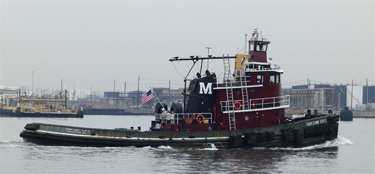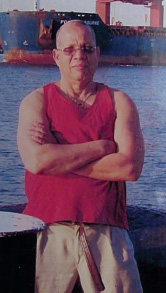A federal court has awarded a multimillion-dollar judgment to the family of a tugboat deck hand who was killed in a capstan-related accident on New Jersey’s Hackensack River in 2009.
Contradicting the findings of the U.S. Coast Guard’s casualty investigation, the judge deemed Moran Towing Corp. to be liable in the death of Ricardo Young, 58, aboard the 91-foot Turecamo Girls.
The company had argued that Young caused his own death because he pushed the wrong button on the capstan control and became trapped in the capstan as it spun in reverse instead of forward. After hearing evidence in a 2013 civil trial, however, U.S. District Judge Robert Sweet concluded that the cause of the fatality was negligence during an unsafe swing maneuver in which the mate turned the vessel before confirming that the capstan and towline were secure.
The judge in November ruled that the mate at the tug’s controls caused the accident, and Moran had failed to establish policies for a swing maneuver even though the company knew that such a maneuver is dangerous. Moran, based in New Canaan, Conn., said it may appeal the court’s decision.
The incident occurred Dec. 27, 2009, while Turecamo Girls was pushing the sludge barge Lisa downriver from Little Ferry, N.J., to Newark. The starboard push line passes the starboard aft quarter bitt around the 10-hp capstan on the aft deck to the H-bitt. At the time, the capstan’s electronic controller was 36 inches from the capstan.
The crew was performing a swing maneuver in order to bring in slack that developed as the vessels progressed downriver. Three turns are performed, and the deck hand operates the capstan to pull in slack and then manually unties the towline that has been wrapped around the H-bitt. He pulls in slack from between the capstan and H-bitt and reties the line on the H-bitt.
During a left-rudder turn, the mate recognized that he was swinging the vessels too far past his reference marker, a condominium complex on the river’s eastern bank.
|
Courtesy Kreindler & Kreindler |
|
A federal judge has ruled that an unsafe swing maneuver caused the death of deck hand Ricardo Young, above, in 2009 in the Hackensack River. Young was ensnared and crushed in the tug’s capstan. |
“After the left swing went too far past the condos, (the mate) then put in ‘right rudder’ to check the left swing although he had not received the ‘all fast’ from Young,” Sweet wrote.
“The towline pulled off the capstan as a result of (the mate) putting in ‘right rudder’ to check the left swing before getting the ‘all fast’ from Young and ensuring that the capstan was secure,” the judge wrote. “(The mate’s) combined errors thus directly resulted in the rapid pulling off of the towline, the capture of Young in the capstan and the subsequent fatal crushing of Young as the towline pulled off with great force.”
Although the company was aware of previous fatalities involving capstans, its officials failed to write swing-maneuver procedures or a risk analysis, the judge noted. For example, there was no written instruction that the captain or mate at the controls must wait for the “all fast” call before turning back to the right.
“Moran did not employ a job hazard assessment for the line handling including the swing maneuver, despite the fact that the swing maneuver conducted by Moran is the type of operation that is amenable to a job hazard analysis because it is a task that involves a capstan that comes under heavy load and strain,” Sweet wrote.
Without written procedures, safety practices varied from captain to captain, said Daniel Rose, a maritime attorney representing Young’s widow in the civil case. The lack of a consistent safety policy led directly to the fatal accident, the judge said.
“In a normally and correctly executed swing maneuver … the deck hand would have had time to finish making fast the H-bitt before the final right turn, and this would prevent the line from pulling out and allow the capstan to hold the line,” Sweet wrote.
The judge called the 36-inch space between the Turecamo Girls’ capstan and capstan controls — in a triangular area including the H-bitt — a “danger zone.” He noted that there is 6 to 7 feet of space between the capstan and controller aboard other Moran tugs. The 1,950-hp Turecamo Girls was built in 1965.
“The controller was placed very close to the capstan so it can be a one-man operation,” said Rose.
The federal Occupational Safety and Health Administration (OSHA) cited Moran for providing an unsafe workspace. OSHA’s report stated that the deck hand “operated an electronically powered capstan that had no guarding to prevent the employee from being pulled into the nip point.”
Moran contested the citation, and OSHA withdrew it. The company did agree to move Turecamo Girls’ capstan controller to the other side of the H-bitt.
Moran’s theory that Young had caused his own death by hitting the wrong button was based on a discovery that the reverse relay had overloaded and tripped out. The claim formed the basis of the Coast Guard’s investigative report. Witnesses said about 30 to 50 feet of line was found payed off.
Young had worked aboard Turecamo Girls for over a year and for Moran since 2006. He was an experienced deck hand and bosun before that. Rose said it’s not realistic to believe that he would spool out so much line in error. Equipment tests and witness testimony indicated that the company’s scenario was unlikely, the judge decided.
Rose said other towing companies had stopped performing swing maneuvers even before the Turecamo Girls fatality.
“It’s an anachronistic maneuver and just wasn’t given the attention it deserved. It’s extremely dangerous. It can be done safely, but it does have the risk of going horribly wrong,” Rose said. “The rule should have been not to introduce ‘right rudder’ until you get ‘all fast.’”
Moran disagrees with the judge’s conclusions, Moran’s chairman and chief executive, Paul Tregurtha, said in a statement to Professional Mariner.
“We are highly disappointed in the court’s decision particularly since it is inconsistent with the results of the investigations conducted by the Coast Guard and OSHA. Moran is currently evaluating an appeal of this decision,” Tregurtha said. He declined further comment while the legal case is pending.
The Coast Guard declined to comment on whether it stands by its casualty report or will revisit the investigation, said Chief Warrant Officer Russell Tippets, a spokesman for the New York district.
Young, of Queens, N.Y., is survived by his wife and two children.


